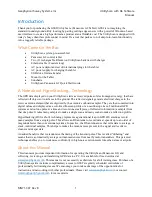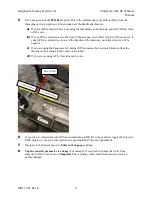
Geophysical Survey Systems, Inc.
UtilityScan with GS Software
Manual
MN71-307 Rev B
11
In the Filters Area
Low Pass/High Pass Filters:
These filters are crucial to
reducing external signal interference in the field. Without
any filtering, the antenna’s receiver will record anything in
the frequency range of radiation that it encounters. By
applying an IIR frequency filter, you can filter out any
frequencies
outside the
range specified. For the 350MHz
antenna, the frequency range of interest is around 100 –
1000MHz. The High Pass allows anything
higher
than the
entered frequency to stay in the data, and the Low Pass
allows anything
lower
than the entered frequency to remain
in the data.
Stacking (Scans):
This is optional. It can help reduce the
amount of noise visible in data. If you decide to use it,
smaller values are crucial. Large stacking values will cause
scans to average to the point of erasing targets of interest.
GSSI recommends a stacking value between 3-11 if you
choose to use the stacking function.
Background Removal:
This is an optional filter that can
help to remove external low-frequency noise and may improve target visibility in high dielectric, wet,
and/or conductive materials. The background removal filter removes any reflector that appears for
more
than the input scan value at the same time, depth, and amplitude across scans. External low-frequency
noise often manifests as horizontal banding, and conductive materials can produce a fair amount of
ringing or horizontal banding. This filter removes horizontal banding that may be overprinting features of
interest. GSSI recommends a scan value of at least 100-200 scans to prevent erasing features of interest.
A good rule of thumb is to set this filter to a value greater than your target length times your scans/ft or
meter. Using very large values may cause a lag in data population on the screen, as the system must
record the number of scans input before displaying the filtered data.
Noise Band Removal:
This is also an optional filter. Enabling Noise Band Removal applies a smart
background removal that is weighted to remove horizontal banding while minimally impacting hyperbolic
features.
Signal Floor:
This is also an optional setting. When Signal Floor is turned on a green field is overlaid on
the Linescan display. This green field is an estimate of the effective depth of each scan based on an
analysis of the noise to signal loss (attenuation).
Summary of Contents for UtilityScan 50350HS
Page 1: ...MN27 151 Rev A MN71 307 Rev B ...
Page 4: ...Geophysical Survey Systems Inc UtilityScan with GS Software Manual ...
Page 6: ...Geophysical Survey Systems Inc UtilityScan with GS Software Manual ...
Page 8: ...Geophysical Survey Systems Inc UtilityScan with GS Software Manual MN71 307 Rev B 2 ...
Page 14: ...Geophysical Survey Systems Inc UtilityScan with GS Software Manual MN71 307 Rev B 8 ...
Page 20: ...Geophysical Survey Systems Inc UtilityScan with GS Software Manual MN71 307 Rev B 14 1 2 3 4 ...
Page 46: ...Geophysical Survey Systems Inc UtilityScan with GS Software Manual MN71 307 Rev B 40 ...
Page 47: ...Geophysical Survey Systems Inc UtilityScan with GS Software Manual MN71 307 Rev B 41 ...






























